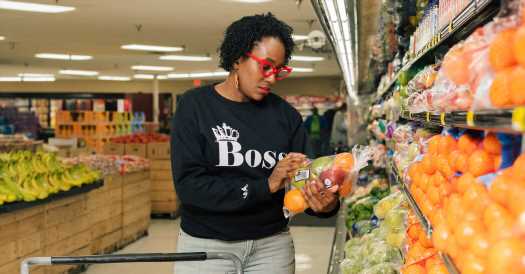Higher Food Prices Bring Bigger Profits, but Consumers Start to Resist
Brenetta Smith used to buy brand-name foods like Oreos and Doritos without thinking twice. But when she noticed that food prices at her local supermarket, Aldi, were soaring, she realized she had to do something different: “I have to change the way I shop,” she said.
So Ms. Smith, 40, a stay-at-home parent in Memphis, started stocking up on dry goods like rice and flour, freezing meat that she bought on sale and avoiding packaged foods, which meant no more Oreos and Doritos. “We’ve cut out all of the snacks,” she said.
Now that she has developed new habits and found that her approach helps stretch her husband’s salary as a cable technician, she doesn’t plan to go back to her old ways.
“Even when the world returns to normal, you can still maximize your paycheck and your income,” Ms. Smith said. She started posting budget tips on TikTok in December, and she quickly amassed a following.
Americans have faced substantial inflation at grocery stores and restaurants. Over the past year, overall food prices were up 8.5 percent as consumers paid more for staples like eggs, fruit and meat.
And corporations that wrested back pricing power during the pandemic may be reluctant to give it up. In earnings reports over the past week, some of the biggest packaged food companies said they raised their prices last quarter and saw their profits go up.
But there have been signs that consumers are starting to resist price increases by cutting back or trading down to lower-priced options. Some of the same multinational companies that raised prices on food said the volume they sold went down.
Brands risk alienating consumers with these high prices, said Sucharita Kodali, a retail analyst at Forrester. “Customers may or may not come back,” she said. “At some point, they will say enough is enough.”
For now, many major companies are raising prices enough that gains are offsetting drops in sales volume. PepsiCo, which makes products like Quaker Oats and Cheetos, said on Tuesday that it increased prices 16 percent in the latest quarter, helping its profit grow 18 percent (excluding its sale of a juice company last year), even as volume fell 2 percent.
Nestlé, whose portfolio includes Hot Pockets and Perrier water, said on Tuesday that it increased its prices 9.8 percent in the last quarter but that volume fell half a percent — an improvement from the prior quarter, when volume dropped 2.6 percent.
And on Thursday, Unilever, the consumer goods giant that makes about a third of its revenue from food brands, announced that it had raised prices 13.4 percent on items like Hellmann’s mayonnaise, and that volume fell 1.3 percent.
So far, “what we are seeing is the willingness to pay up for things you need,” said Simeon Siegel, a retail analyst at BMO Capital Markets, adding that items like milk and perishable groceries must be replenished often.
But consumers may start reallocating their spending. “For companies that are able to maintain price elevation, they’re going to see their profits go higher,” he added.
Coca-Cola, for example, raised prices last quarter, and its profit jumped 12 percent, to $3.1 billion.
In general, consumers are continuing to spend. The U.S. economy grew at a 1.1 percent annual rate in the first quarter, the Commerce Department reported on Thursday, the third consecutive quarter of growth after output went down in the first half of last year.
And food inflation has been abating. In March, food prices were flat compared with the month before, according to the Consumer Price Index, and prices for food at home fell 0.3 percent. But prices at restaurants continued to go up, rising 0.6 percent from February.
Still, some customers are changing their buying habits. Kylie Park, 31, used to buy three or four boxes of Pop-Tarts Bites for her son on trips to her local Safeway in Oahu, Hawaii. But the treats have become more expensive, so she often buys just one package at a time. She also stopped buying as much juice, she said, and has been skipping her trips to Costco for bulk goods.
“Before, I would overbuy; I realized I don’t need all of that,” said Ms. Park, who works as a part-time aesthetician and content creator. “I don’t think I would go back.”
She added that she had mostly just paid the higher prices on staples, allocating more of her budget to groceries. “Everything I buy is normally everything we eat,” she said.
Other consumers are opting to buy cheaper generic products. When companies raise prices too much, consumers seek alternatives, Ms. Kodali said. “You basically introduced a bunch of people who were your audience to your competitors,” she said. “What you end up seeing is a trade-off.”
Dianna Anderson’s attitude toward cereal brands used to be: “If I can’t get the name brand, I won’t get it.” But when inflation started eroding their breakfast budget, Mx. Anderson, 37, who uses they/them pronouns, started buying generic cereal at Target.
“I would probably stick with the Target brand,” said Mx. Anderson, a writer who works at a nonprofit organization in Minneapolis. “It’s a decent product, and it’s cheaper.”
Fast food restaurants have likewise seen profits rise as they raise prices.
McDonald’s announced this week that it had “strategic menu price increases” in the recent quarter. Same-store sales were up 12.6 percent, and its profit rose 63 percent from a year earlier, to $1.8 billion. But the company acknowledged that some customers were cutting back.
“I’m really proud of how our system has executed pricing in light of the double-digit inflation that we have been experiencing,” Christopher J. Kempczinski, chief executive of McDonald’s, said on a call with analysts.
He added that the number of items per order was decreasing slightly — some customers were opting not to add fries. “We are seeing, in some places, resistance to pricing, more resistance than we saw at the outset,” he said.
Ms. Park is among those resisting. She used to go to McDonald’s, her favorite fast food spot, during her lunch break every week, she said. But when she noticed last summer that prices were climbing and portions appeared small, she cut back to once a month.
“Filet-O-Fish is my favorite ever,” Ms. Park said. “It feels like we’re losing out.”
At Chipotle, which has been raising prices for more than a year, average menu prices were up 10 percent last quarter from the previous year, and profit was 84 percent higher. The company also expanded its profit margin, and sales were up.
“I think we’ve now demonstrated we do have pricing power,” Brian Niccol, the chief executive of Chipotle, said on a call with analysts this week. “We have a really strong brand, and we don’t want to be in front of the inflationary environment, but we also don’t want to fall behind.”
Not everyone is happy with the higher costs at Chipotle.
Amy Scalf, 37, was shocked to find that her burrito bowl with guacamole cost more than $11 at a Chipotle near her home in Lexington, Ky. Ms. Scalf, who offers saving tips on social media, said she might start going to Taco Bell instead.
“It’s definitely a deterrent,” she said of the higher prices. “It’s an incentive to go and get an option that’s cheaper.”
Source: Read Full Article


